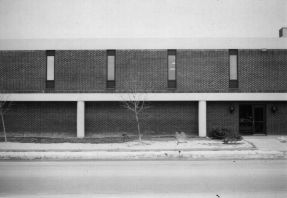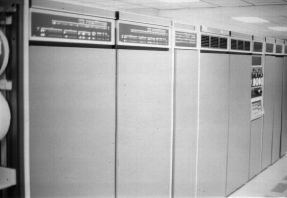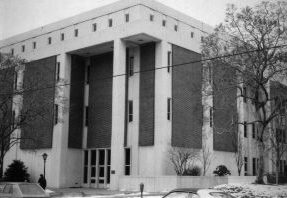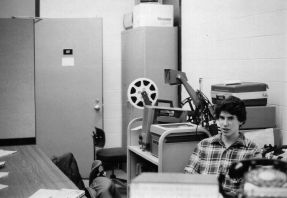Here is a collection of pictures taken by Ernie Perez in 1981, very near the end of Delta. These pictures were taken as part of a photography class assignment. It is interesting to see how cunningly they illustrate the stark reality of the people having been separated from their machines.
The images were scanned in from prints which were made from the original black and white slides. Click on the pictures to view the much larger hi-res GIF versions.
Thanks to Aron Insinga, Eric Thayer, and Randy Gellens for helping me fill in some of the gaps in my memory of the details.
Photos by Ernie Perez
Commentary by Bob Mader
April 10, 1999
The machines: UDCC

Behind the walls of this unassuming building on South Chapel St. were hidden the "big iron" computers of the University of Delaware. Access was very strictly controlled. This building still houses the Computing Center today, but the machines shown below are all long gone.

Behold the Burroughs B7700, the pinnacle of the University's computing empire. This system ran the MCP (Master Control Program) operating system and the CANDE (Command AND Edit, pronounced candy) combination shell and editor. Just about everything was programmed in ALGOL. But the most memorable feature of the B7700 was that it required you to set your terminal to "half duplex."

Here is an artfully composed photo showing a section of the Burroughs disk farm. I'd guess you are looking at considerably less storage than what you have in that 3-1/2 inch hard drive in your personal computer. But the appearance leaves no doubt that you have reached the throbbing center of storage control.

This is a picture of the DEC-10, a 36-bit computer which ran the TOPS-10 operating system. This machine was a favorite target of unauthorized hacking thanks to its familiar Digital-style command-line interface and lax security. Who ever would have thought it was so huge!

Some DEC-10 storage in the form of four RP06's. These disk drives were affectionately referred to as "Kenmores." You are looking at about 700 MB of storage. You can also see a card punch and another unit record device (interpreter?) in the background.

Here is the console and some 9-track tape drives for the Plato system. The Plato computer was a CDC Cyber-173 (?) mainframe. Aron recalls sneaking in a batch FORTRAN job or two before Plato was completely up and running on the machine. Later, the O/S was totally hidden from mere mortals; all access was controlled by the "authoring" language, TUTOR.

The legendary Xerox 1200 laser printer. Printing was accomplished via 9-track tapes and much operator intervention.

And finally, tucked back in the corner, we find that pesky Delta PDP-11/70. On this day, it was receiving some tender loving care from the local DECie techie.

And here's a close up of one of the RP04's. You are looking at a whopping 80 megabytes, spinning very quickly, I might add!
The People: Willard Hall

After the big shake up, Delta's computer was locked up in the computing center and a "staff room" was created in room 203-1 of this building, the College of Education's Willard Hall.

Here's Ernie sitting at his desk in room 133. Ernie was one of the lucky few who was permitted to visit the great computer. He went on to work for RSTS Engineering at Digital.

In another staged photo, we find Joyce sitting at Ernie's desk. I'm not sure if she's miffed about having her picture taken or if she was about to burst out laughing for some reason.

This seems to be David Arenson from Brandywine High School. We are not sure why he is waiting around in Ed Boas's office. Notice the acoustic coupler on the right. After the move out of DuPont Hall, access at anything over 300 baud was a rare luxury. The movie projector and A/V equipment seem to mock the student. In Willard Hall, this was about the full extent of the "hardware" that most Delta staff would have the opportunity to see.

Ed Boas, Delta's leader from 1977 until the end around 1982, in his office at Willard Hall.